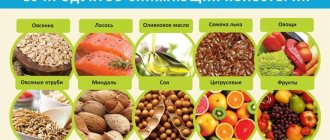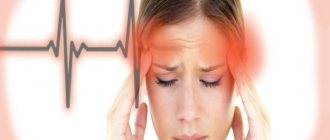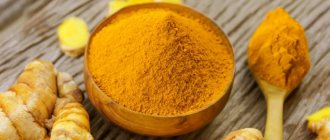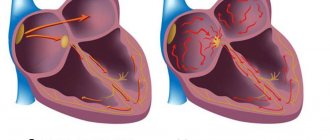Atherosclerosis is a fairly serious disease, which is a leader in causing strokes and heart attacks. It affects the vessels of the brain, the coronary arteries of the heart, peripheral vessels and those leading to the internal organs.
Without proper treatment and a special diet, atherosclerosis will ultimately cause death. Today I will tell you how to eat if you have atherosclerosis, what should form the basis of your diet, and what foods you should avoid. So, let's begin…
Where does atherosclerosis come from?
The main reason for the development of atherosclerosis is a violation of lipid metabolism, which results in the accumulation of cholesterol in the lumen of blood vessels and their further blockage with atherosclerotic plaques. As a result, blood circulation deteriorates, blood thickens and, as a result, blood pressure increases.
In the future, atherosclerosis leads to coronary heart disease and various diseases of the central nervous system, including the already mentioned stroke. But the main root of this problem lies in a person’s unhealthy lifestyle and unbalanced diet.
Regular overeating, abuse of high-calorie fatty and/or fried foods, excess of saturated and hydrogenated fats in the diet causes excess weight and metabolic disorders, which ultimately ends in a diagnosis of atherosclerosis.
That is why the first thing doctors pay attention to after stating this fact is the need to follow a special therapeutic diet. Moreover, changes in diet should occur not only at the time of the acute period or rehabilitation, but throughout life.
Without normalizing your diet, you shouldn’t expect much effect from drug treatment. Even if it is possible to improve the patient’s condition, it will only be for a while, and then an incorrect diet will again lead to a relapse and exacerbation of atherosclerosis with all the ensuing consequences.
Coffee and high cholesterol
If the cause of high cholesterol is liver dysfunction, then even instant coffee is potentially dangerous for the patient. If you have high cholesterol, you can drink insoluble coffee in moderation by passing the drink through a paper filter. The paper filter will retain cafestol along with the oils in which it is concentrated when brewing coffee. Nowadays there are even coffee machines with such filters.
But even instant coffee with high cholesterol is not recommended to be consumed in large quantities. Brewed coffee with cholesterol concentrations above 6.95 mmol/l is contraindicated. However, there are varieties of brewed coffee that are free from cafestol, so here we should talk about the correct selection of drinks.
Coffee cannot cause the formation of cholesterol plaques in blood vessels and, on the contrary, by reducing inflammatory processes in blood vessels, it suppresses the formation of new lesions in them and, as a result, the appearance of fresh atherosclerotic plaques. However, excessive coffee consumption can lead to a sustained increase in blood pressure, which, in turn, provokes stretching and damage to blood vessels, which intensifies the formation of cholesterol plaques.
How does coffee affect cholesterol?
With a normal dosage of the drink - no more than 1 - 2 cups per day - coffee should not have any noticeable effect on cholesterol levels. The effect of coffee on blood vessels is rather positive in this situation. Black coffee has less effect on cholesterol than milk coffee.
Turkish, Scandinavian, expresso and coffee brewed in a coffee machine without subsequent filtration from cafestol can negatively affect the TC level, increasing it from 3 - 5 to 6 - 8% with large (up to 5 cups per day) and daily consumption. Modern coffee makers, however, allow you to filter the drink.
Other drinks, such as sweet tea, have an even lesser effect on cholesterol in blood vessels than coffee.
Diet and treatment of high cholesterol and coffee
Drinking coffee during a diet for high cholesterol or in the treatment of hypercholesterolemia is generally allowed, however, if there are disturbances in the intestinal tract, digestive system and liver, including those leading to disruption of cholesterol metabolism, it may be necessary to exclude coffee and coffee drinks from the diet menu. to reduce cholesterol.
Therapeutic nutrition for atherosclerosis
The main goals of therapeutic nutrition for atherosclerosis are as follows:
- slowing down the development of the disease by reducing the level of “bad” cholesterol in the blood;
- reduction of metabolic disorders;
- normalization and stabilization of lipid metabolism;
- improving blood circulation by reducing cholesterol plaques and thinning the blood;
- reducing the load on the cardiovascular and central nervous systems, liver and kidneys;
- reducing body weight to normal levels (fighting excess weight).
Based on the goals described above, we can formulate the main principles of nutrition for atherosclerosis.
Among them:
1.
The diet of people with atherosclerosis or a clear tendency to develop it should be as varied as possible, but not hypercaloric.
To determine the daily energy value of food, you must first calculate the daily calorie requirement (DC, calculated using the appropriate formula, which is known to all nutritionists and nutrition consultants who have completed courses in dietetics).
Next, 10-15% should be subtracted from the SPC - this will allow you to achieve smooth weight loss without exacerbating hunger and harm to health. To make the dynamics of the fight against extra pounds more noticeable, you should add adequate physical activity, taking into account possible contraindications for certain types of training.
During such competent weight loss, metabolism will accelerate, which will lead to improvement of lipid metabolism, and, therefore, to control of atherosclerosis.
2.
Nutrition for atherosclerosis implies a fractional diet, that is, you need to eat 5-6 times a day in small portions balanced in composition.
3
. It is necessary to drink a sufficient amount of purified still water (about 2 liters per day). It will help thin the blood and cleanse the body of accumulated toxins and waste. As a result, all organs and systems will work much more efficiently.
4.
The basis of the diet should be vegetarian dishes, that is, vegetables, fruits, whole grain cereals, legumes. The amount of saturated fats in the menu should be reduced, since they lead to an increase in the level of bad cholesterol in the blood and the progression of atherosclerosis. Hydrogenated fats are completely prohibited.
People with atherosclerosis should gain their share of lipids as part of a balanced diet by consuming vegetable fats and healthy fatty acids, for example, Omega 3, 6 and 9.
You can find the right fats in unrefined, cold-pressed vegetable oils, nuts, fish, seafood (except caviar), avocados, and seeds.
Lean types of meat are allowed for consumption in limited quantities: chicken and turkey fillet, rabbit, game, quail. But pork, beef, ducks, geese and offal (liver, lungs, heart, tongue, brain, etc.) will have to be abandoned altogether. The same applies to crack broth, including first courses prepared with it.
The number of eggs is reduced to 2-3 per week (if you want more, then only the white without the yolk).
5.
You should limit foods and drinks that stimulate the central nervous system, for example, coffee, strong tea, chocolate.
6.
It is necessary to add as many foods containing dietary fiber to your diet as possible. These include whole grain cereals, breads, baked goods and wholemeal pasta, bran and powdered fiber.
Dietary fiber creates a long-lasting feeling of fullness, provided that the foods containing it are usually low in calories. You should consume at least 400 grams of vegetables and fruits per day.
7.
Reduce salt and sugar intake.
8.
Do not overeat and adhere to healthy eating habits.
9.
1-2 times a week, arrange fasting days on kefir, buckwheat, oatmeal, vegetables or apples. This will help the body cleanse itself and will be an excellent aid for weight loss.
Treatment of aortic atherosclerosis
Treatment of aortic atherosclerosis:
- Diet No. 10. Loss of body weight.
- Statins: lovastatin 20-80 mg/day. up to 2 years.
- ANOS: cholestyramine IV 4-24 g/day. (questran, quantalan); cole-stipol 10.0×2 r/d.
- Nicotinic acid 0.03 g, (|TG). Enduracin 250-2000 mg/day.
- AOX: vit. E; Pycnogenol 0.5×1 r/day.
- Disaggregants: thromboass 0.1x 1 time per day, trental 0.1x3 times per day. Consultation with a cardiac surgeon
- Fibrates: gemfibrozil 0.9-1.2 g/day, 2 times a day daily. Probucol 0.5×2 times a day.
- Phospholipids: Essentiale 2×3 times a day for 1 month. Leticin 1X3 r/d.
- Vasoprotectors: actovegin 1×3 times a day, pycnogenol 0.1×1 times a day.
- Surgical treatment: ILS, EOL, PCVS, liver transplantation, hemosorption.
Active observation for aortic atherosclerosis:
S. Vyalov, A. Epmolov, S. Chorbinskaya, E. Chernienko, T. Vasina, V. Kyznetsov
Permitted and prohibited foods for atherosclerosis
Now let's move on directly to the menu that can be recommended for people with atherosclerosis.
List of permitted products:
- Meat (in small quantities!): chicken and turkey fillet, rabbit, lean veal, skinless chicken, quail.
- Fish: all white fish (cod, flounder), herring, sardines, tuna, salmon (chum salmon, pink salmon, salmon).
- Fats: olive, sunflower, soybean, corn oil, nuts, seeds (sesame, flax, chia).
- Dairy and fermented milk products: skim milk, low-fat cheeses (pressed cottage cheese), kefir, yogurt, natural yogurt, low-fat cheese, ayran.
- Legumes: peas, beans, lentils, asparagus, soybeans.
- Vegetables and fruits: carrots, beets, tomatoes, cucumbers, onions, garlic, zucchini, peppers, eggplants, cabbage, boiled potatoes (or in their jackets).
- Cereals: buckwheat, oatmeal, brown rice, pasta and wholemeal bread.
- Baked goods: low fat puddings, jellies, sorbet.
- Drinks: green tea, natural fresh juices without sugar, compote or uzvar without sugar, still mineral water.
Menu (Power Mode)
5-6 meals a day are organized. The menu for several days may look like this:
The first day
| Breakfast |
|
| Lunch |
|
| Dinner |
|
| Afternoon snack |
|
| Dinner |
|
| For the night |
|
Second day
| Breakfast |
|
| Lunch |
|
| Dinner |
|
| Afternoon snack |
|
| Dinner |
|
| For the night |
|
Day three
| Breakfast |
|
| Lunch |
|
| Dinner |
|
| Afternoon snack |
|
| Dinner |
|
| For the night |
|
Useful tips for beginners to cook healthy food
- Replace salt with herbs and spices. Today on supermarket shelves you can find a special “cardiological” salt, in which KCl has been added to NaCl. The taste effect is the same, but less harmful. You can also use a small amount of sea salt, which is available in supermarkets and pharmacies.
- If you use spices, it is better to grind them yourself before cooking (for example, peppers or coriander) in a special grinder. When choosing ready-made seasonings in the store, pay attention to the composition - the flavor enhancer monosodium glutamate should not be added to the seasonings. This substance significantly increases appetite and promotes overeating and obesity. For example, large amounts of glutamate are found in packets that come with Chinese noodles and bouillon cubes (Maggi, Galina Blanca, etc.).
- Do not use bouillon cubes or prepared soups (canned or powdered).
- If you cook meat broth, it should not be strong; when the meat boils, the first broth must be drained and the soup should be cooked in the second (third) broth.
- If the recipe calls for milk, use skim milk.
- Instead of mayonnaise, season salads with yogurt, kefir, sour milk or olive oil and sauces prepared on its basis with the addition of apple or balsamic vinegar, spices and herbs.
- Tomato sauces for pasta and other dishes are preferable. Avoid sauces made with cream.
- A frying pan with a non-stick coating or special steel cookware with a thick bottom (for example, Zepter) will allow you to avoid fat and cook fried meat, fish, and chicken tasty and healthy.
- Avoid buying processed foods that are high in fat, salt and sugar.
Foods rich in potassium, magnesium and calcium salts
For a person with heart and vascular disease, it is very useful to eat foods rich in potassium, magnesium and calcium salts
. A significant amount of potassium is found in baked potatoes (“in their jackets”), raisins, dried apricots, prunes, beans, peas, beets, radishes, currants, peaches, apricots, bananas, and fish (cod, hake). Moderate amounts are found in chicken, buckwheat, millet, carrots, zucchini, pumpkin, plums and oranges. Dairy products are rich in calcium. Even if you drink skim milk, two glasses are enough to meet your daily calcium requirement. The most magnesium is found in products of plant origin, especially wheat bran, soy flour, sweet almonds, peas, wheat, apricots, and white cabbage.
Healthy food does not mean tasteless food that no one wants to eat. The diet recommended for the prevention of cardiovascular diseases is often called “Mediterranean”, since its basic principles form the basis of the national cuisine of the Greeks, Italians, French and Spaniards. A large amount of sea fish, fruits and vegetables, salads and olive oil allowed Mediterranean peoples to suffer less from atherosclerosis. So let's learn the best and most useful things!






